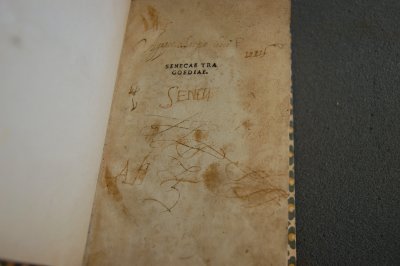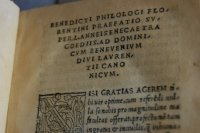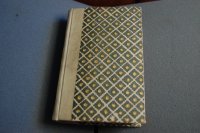The Alta Collection
SENECA, Lucius Annaeus (c. 4 BCE-65 CE)
Tragoediae (1513) owned by the Borgia family
$8000
Item Details
Florence, Giunta, 1513
Seneca, Lucius Annaeus. Tragoediae. Florentia. Sumptibus Philippe de Giunta Florentini. M.D.Xiii. (Firenze/Florence, Giunta, 1513.) Edited by Benedicti Philologi Florentini (Benedetto Ricciardini).
Hard Cover. 8 p. l., 215 numbered leaves (a-z8, &8, A-D8, D8, blank?, wanting). Imprint from colophon (leaf 215 recto). The second Florence edition, a reprint of the 1506 edition. Some marginal annotations, seemingly of the 16th century, but trimmed. A number of woodcut ornamental initials. Very good copy, water stain across back pages of the volume. In an Italian binding, with vellum spine and paper covered boards. Has owner signature “Agapoti Borgia” in humanistic cursive.
Seneca’s philosophical work remained popular throughout the late Roman and medieval periods, thanks to the approval of the early Christian church. The plays, however, experienced a significant revival during the 15th-16th centuries, largely driven by Italian humanists. The first printed edition of Seneca’s plays was published in Ferrara in 1484. This 1513 edition of the plays was edited by Benedetto Ricciardini. Ricciardini, the grammar teacher at the school of San Lorenzo in Florence, edited numerous texts for the leading Florentine publisher Filippo Giunti. Ricciardini taught many leading Florentines, including, according to some, Niccolo Machiavelli. Beginning in the 1560s, students at the English universities and Inns of Court began translating and circulating Seneca’s plays. As a result, Seneca’s work profoundly influenced early modern English theatre.
The owner signature in this copy of Tragoediae, which reads “Agapoti Borgia,” is ambiguous. It may refer to Agapito Geraldini (1450-1515), who served as Cesare Borgia’s secretary and advisor, and whose perspicacity was praised by Machiavelli. (Agapito is played by Paul Brennen in the television drama Borgia.) Geraldini, a member of a prominent family in Amelia, was a serious scholar; before his work for Cesare, he held positions at the head of the Benevento library and the Abbreviator of Apostolic Letters, which entitled him to live in the papal palace. In that role, he composed the first drafts of papal letters and inspected the final documents. He was also active in the Accademia Romana (Roman Academy), a circle of humanists gathered together by Pomponio Leto. Given this association, it is likely he would have owned a copy of Seneca. The Academy studied and celebrated classical antiquity and were crucial to building Seneca’s reputation as a dramatist. In 1486/88, one member, Giovanni Sulpizio da Viroli, staged a production of Seneca’s Phaedra for Pope Innocent VIII. This was one of the first productions of a Roman tragedy since antiquity.
This provenance remains unconfirmed, however. The signature reads “Agapoti” rather than “Agapito,” and the use of the surname Borgia may not accord with Geraldini’s usual practices. Other candidates exist—the librarian who compiled the Indice Vecchio, a 1480s catalogue of the Duke of Urbino’s famous library, was also named Agapito, for example. In Greek, “agapoti” means “dear”—perhaps the words are a fond inscription rather than a signature. And what of the “Borgia?” A direct Borgia/Seneca connection exists—from c. 1488-1491, Cesare Borgia’s private tutor was a man named Paolo Pompilio, a member of the Roman Academy who published a book on Seneca in 1490. That book, Vita Senecae, was dedicated to Giovanni Lopez, Rodrigo Borgia’s secretary. It seems unlikely that Seneca would not have featured in young Cesare’s education.
USTC 855884
Catalogue description by Dr. Molly G. Yarn
Literature
Black, Robert, ‘Machiavelli and the Grammarians’, Archivio Storico Italiano, 173.3 (2015), 427–82
Busolini, Dario, ‘GERALDINI, Agapito’, Dizionario Biograficodegli Italianihttps://www.treccani.it/enciclopedia/agapito-geraldini_(Dizionario-Biografico)
Machielsen, Jan, ‘The Rise and Fall of Seneca “Tragicus”,c.1365–1593’, Journal of the Warburg and Courtauld Institutes, 77 (2014), 61–85
Pettas, William A., The Giunti of Florence: A Renaissance Printing and Publishing Family: A History of the Florentine Firm and a Catalogue of the Editions (Oak Knoll Press, 2013)
Schironi, Francesca, ‘The Reception of Ancient Drama in Renaissance Italy’, in A Handbook to the Reception of Greek Drama, ed. by Betine van Zyl Smit (Hoboken, NJ: John Wiley & Sons, Inc,2016), pp. 131–53
Schubert, Werner, ‘Seneca the Dramatist’, in Brill’s Companion to Seneca, ed. by Andreas Heil and Gregor Damschen (Leiden, The Netherlands: Brill, 2014), pp. 73–93
Winston, Jessica, ‘Seneca in Early Elizabethan England’, Renaissance Quarterly, 59.1 (2006), 29–5
The Alta Collection
Eric Rasmussen
1004 Placid Creek Ct
Round Rock, TX, 78665
United States
Phone: 9252124132
Featured Catalogue
Visit Website
Specialities
Shakespeare, Early English Books, Manuscripts
More Information
Booth 5
Shipping and Returns
2-day FedEx, USPS, or UPS shipping



